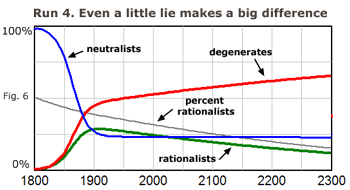The Principle of Cumulative Advantage
The Principle of Cumulative Advantage states that once a social agent gains a small advantage over other agents, that advantage will compound over time into an increasingly larger advantage. The effect is well known and is embodied in "the rich get richer and the poor get poorer". The principle is also known as the Matthew effect. The term was coined by sociologist Robert Merton in a 1968 paper which described how the more eminent scientists in a group tend get the most credit for the group's work, regardless of who did the work.
How the principle affects large social problems
The Principle of Cumulative Advantage lies at the heart of many large social problems. It's the causal mechanism for income inequality growth, corruption growth, centralization of power growth, and hardening of class stratification.

Run 4 from the Dueling Loops of the Political Powerplace model. The rationalist and degenerate politicians start with almost equal advantage. But the degenerates have the slight advantage of 10% of their "here's why you should elect me" messages to neutralist voters are false but appear to be true.
This gives the degenerates a tiny advantage that, over time, compounds into a big one. A similar graph could be drawn for every case where the Principle of Cumulative Advantage is at work.
All social agents, from people to families to corporations to nations, seek to maximize their competitive advantage. If they don't they are gradually weeded out by the law of survival of the fittest. The greatest advantage a social agent can have is a reinforcing feedback loop that increases (cumulates) their competitive advantage.
All social interaction is ultimately an attempt to increase one's competitive advantage directly, or increase it indirectly by strengthening the loop. If there are any delayed adverse repercussions, then loop growth will overshoot its limits and then collapse as system self-correction occurs. This is precisely what has caused the sustainability problem. It's a side effect of the growth loops dominant social agents have built for themselves to maximize their competitive advantage. The Race to the Bottom among Politicians of the Dueling Loops is one example.
It's also what caused the two problems of authoritarian rule and widespread poverty. Most of a population's power or wealth was accumulated by the ruler at the top or the rich. The autocratic ruler problem was solved by invention of democracy. The widespread poverty problem was solved, somewhat, by the policy of progressive income taxes and creation of "let's take care of each other" programs like unemployment insurance, social security, and old age health insurance. All developed nations have found it best to institute these policies to various degrees, because they are so beneficial to the common good.
The lesson here is a Cumulative Advantage Growth Loop was the main mechanism of these two problems. To solve the problem, the loop had to be counteracted by creation of new feedback loops like the Voter Feedback Loop and the Progressive Transfer of Wealth loop, in order to prevent catastrophic results. Similar loops will be required to solve the sustainability problem.


























